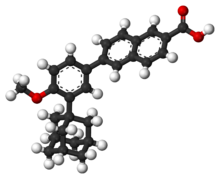 | |
 | |
| Clinical data | |
|---|---|
| Trade names | Differin, others |
| AHFS/Drugs.com | Monograph |
| MedlinePlus | a604001 |
| License data | |
| Pregnancy category |
|
| Routes of administration | Topical |
| Drug class | Retinoids |
| ATC code | |
| Legal status | |
| Legal status | |
| Pharmacokinetic data | |
| Bioavailability | Very low[medical citation needed] |
| Excretion | Bile duct |
| Identifiers | |
| |
| CAS Number | |
| PubChem CID | |
| IUPHAR/BPS | |
| DrugBank | |
| ChemSpider | |
| UNII | |
| KEGG | |
| ChEBI | |
| ChEMBL | |
| CompTox Dashboard (EPA) | |
| ECHA InfoCard | 100.149.379 |
| Chemical and physical data | |
| Formula | C28H28O3 |
| Molar mass | 412.529 g·mol−1 |
| 3D model (JSmol) | |
| |
| |
| (verify) | |

Adapalene is a third-generation topical retinoid primarily used in the treatment of mild-moderate acne, and is also used off-label to treat keratosis pilaris as well as other skin conditions.[6] Studies have found adapalene is as effective as other retinoids, while causing less irritation.[7] It also has several advantages over other retinoids. The adapalene molecule is more stable compared to tretinoin and tazarotene, which leads to less concern for photodegradation.[7] It is also chemically more stable compared to the other two retinoids, allowing it to be used in combination with benzoyl peroxide.[7] Due to its effects on keratinocyte proliferation and differentiation, adapalene is superior to tretinoin for the treatment of comedonal acne and is often used as a first-line agent.[8] The Swiss company Galderma sells adapalene under the brand name Differin.
- ^ Anvisa (31 March 2023). "RDC Nº 784 - Listas de Substâncias Entorpecentes, Psicotrópicas, Precursoras e Outras sob Controle Especial" [Collegiate Board Resolution No. 784 - Lists of Narcotic, Psychotropic, Precursor, and Other Substances under Special Control] (in Brazilian Portuguese). Diário Oficial da União (published 4 April 2023). Archived from the original on 3 August 2023. Retrieved 15 August 2023.
- ^ "Differin- adapalene gel". DailyMed. 7 December 2022. Retrieved 15 May 2024.
- ^ "Differin- adapalene cream". DailyMed. 31 October 2022. Retrieved 15 May 2024.
- ^ "Differin- adapalene gel". DailyMed. 27 December 2023. Retrieved 15 May 2024.
- ^ "Differin- adapalene lotion". DailyMed. 19 April 2023. Retrieved 15 May 2024.
- ^ Rolewski SL (October 2003). "Clinical review: topical retinoids". Dermatology Nursing. 15 (5): 447–50, 459–65. PMID 14619325.
- ^ a b c Tolaymat L, Dearborn H, Zito PM (June 2023). "Adapalene". StatPearls [Internet]. Treasure Island (FL): StatPearls Publishing. PMID 29494115.
- ^ Asai Y, Baibergenova A, Dutil M, Humphrey S, Hull P, Lynde C, et al. (February 2016). "Management of acne: Canadian clinical practice guideline". CMAJ. 188 (2): 118–126. doi:10.1503/cmaj.140665. PMC 4732962. PMID 26573753.